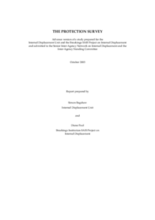In December 1999, the Inter-Agency Standing Committee (IASC) adopted its policy paper on the protection of internally displaced persons, through which the heads of UN agencies acknowledged that the protection of internally displaced persons “must be of concern to all humanitarian/development agencies”. The policy paper was described as part of a growing effort by international organisations “to address more proactively the needs of internally displaced persons, to assess and analyse those needs, and to act when the rights of the internally displaced are being violated.” Four years on, to what extent have UN agencies addressed the problem of providing effective and meaningful protection to the displaced? Just how proactive are they? To what extent do they act when the rights of the displaced are being violated? Indeed, just how engaged are humanitarian and development agencies in providing protection to internally displaced persons?
In an effort to throw some light on these questions, the Internal Displacement Unit and the Brookings Institution-SAIS Project on Internal Displacement undertook a joint “protection survey”. The aim of the survey is to examine through a series of country missions the way in which UN country teams and other relevant actors work to support states in discharging their primary responsibility for the protection of internally displaced persons or, in some cases, directly provide protection themselves.
Drawing upon the IASC protection policy paper and other relevant documents, part one of the report describes the theoretical context of the survey, with an explanation of what is meant by the term “protection”. It also discusses the apparently straightforward but at times contentious question of who is responsible for acting to protect displaced persons and those at risk of displacement.
Part two draws upon the findings of the field missions and, using the protection policy paper as a frame of reference, discusses protection in practice: the manner in which protection activities are carried out in the field by UN and other relevant actors. It notes that significant efforts are being undertaken in the field by UN staff to protect the displaced and under difficult, complex and often extremely dangerous circumstances. However, it observes that such efforts are largely ad hoc and are often driven more by the personalities and convictions of individuals than by any institutional agenda, as underlined by the fact that in some cases their efforts lack the required support (sometimes verging on opposition) from headquarters. In short, international protection of the internally displaced is not undertaken in any sort of predictable, consistent or systematic manner. And on occasion, deliberately or otherwise, it may be overlooked altogether.
Part three contains a number of recommendations as to how field-based protection could be undertaken more effectively and, most importantly, more systematically.
©Internal Displacement Unit and Brookings Institution-SAIS Project on Internal Displacement

